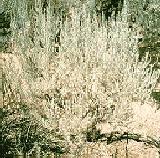

U.S. D. A. Photo
Wyoming Big Sagebrush
Artemisia tripartita (Nutt.)
ssp. wyomingensis Beetle and Young
Value for Wildlife:
Wyoming big sagebrush is preferred browse for wild ungulates, and Wyoming big sagebrush communities are important winter ranges for big game. On the Idaho National Engineering Laboratory, for example, the shrub comprised 90% of the diet of pronghorn from fall through spring. Wyoming big sagebrush is a crucial food item of sage grouse, and Wyoming big sagebrush communities are critical habitat for the birds.
Planting:
Wyoming big sagebrush reproduces from seed; it
does not sprout or layer. Pollination is mostly by out crossing, but plants can
also self pollinate. Shrubs produce large quantities of small seeds beginning at
3 to 4 years of age. Goodwin estimated that a moderate-sized plant produces
about 350,000 seeds in a season, and a large one produces over a million. Big
sagebrush seed is disseminated mostly by wind, with some seed spread by animals
and water. The seed floats, so seedlings may establish along watercourses . Most
seed shatters within a week of maturation and travels less than 100 feet (30 m)
from the parent plant. Some viable seed is retained on the parent and
disseminates slowly over the winter . Establishment occurs mostly from the seed
bank. Wyoming big sagebrush seed stored in the warehouse has retained viability
for at least 6 years ; viability in the field is unknown. On burns, Wyoming big
sagebrush that escape fire are an important seed source . If the seed bank is
destroyed over a large area by repeated fires or other means, Wyoming big
sagebrush eventually seeds in from adjacent areas, but such a strategy may take
several decades.